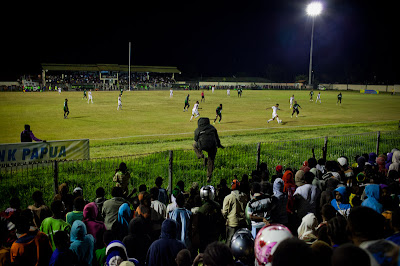Happy Sunday! I hope all is well.
I've been in Wamena for almost a month and everything is doing good so far.
I've been working with my new friends at Yukemdi, a local NGO in Wamena led by Pak Yoram Yogobi. I worked with Yukemdi briefly during my first visit in 2009. Currently, the number of people infected with HIV/AIDS in this region is 1533, but this number is estimated to be 3-4 times higher and Pak Yoram and his team are dedicated in educating the public on HIV/AIDS, assist those already infected, and reduce stigma. After explaining my mission, Pak Yoram and my new friends at Yukemdi welcomed me as a part of the team.
 |
| At Pasar Baru market handing out educational pamphlets on HIV/AIDS. Yukemdi included their office telephone number and address in the back each pamphlet for anyone who wants to contact them directly or get their immediate assistance. |
 |
| Curious and interested, many people surrounded the truck to get information |
 |
| Explaining the content of the pamphlet |
 |
| Educating the public on Sexual Transmitted Diseases (STD) |
 |
| My friends at Pasar Baru Market |
Perhaps one of the most effective ways of spreading information, promoting communication, and understanding on the subject of HIV/AIDS to the general public is by visiting villages and playing educational movies. Although books and pamphlets are good sources of information, they could be ineffective since illiteracy in this region is quite high and people here speaks various dialects as their main language other than Bahasa Indonesia (national language).
Earlier this week, Pak Yoram and I visited Village Husoak, about 15km from Wamena. The village elder had requested Pak Yoram since last year to come down to his village and to play a movie to educate the people in his village about HIV/AIDS. Nevertheless, the biggest obstacle for Pak Yoram has always been the lack of transportation. In the past, Pak Yoram had bring his laptop and in-focus projector and chartered vehicles to go to villages and play movies. But it had become too expensive. Moreover, since most of the villages he visited had no electricity, he had to use gas-powered generator. Because the electricity current is inconsistent, several laptops and projector had been burned.
KPA (Komisi Penangulan AIDS) or National AIDS Commission has a vehicle in Wamena equipped with sound and projector system and surge protector for this task. Nevertheless, the truck is not available all the time since it could only be used when KPA is not using it. I asked Pak Yoram why there is only one truck if this method is so effective and he told me that he had been wondering the same thing. He added, there is not one place in Wamena and surrounding area he couldn't reach without the proper transportation. Luckily for us that day, the KPA truck was available for us to use.
 |
| Pak Yoram arriving at Village Husoak |
 |
| Unloading equipment |
 |
| Village elder of Husoak |
 |
| Putting the projector screen together |
 |
| No Electricity at the village, using gas- powered generator to run the projector and speakers. The vehicle is equipped to handle the erratic electric voltage. Doing such task in the past with other vehicles had ruined several laptops and projectors. |
 |
| Setting up the movie. The KPA vehicle is equipped with speakers, projector, amp, etc. |
 |
| Villagers of Husoak watching an educational movie on HIV/AIDS |
 |
| The children sits right up front |
 |
| Add caption |
This educational movie about HIV/AIDS attract hundreds of audiences including children and adults, it provides entertainment and information in a medium that is easy to understand. Moreover, the audience is able to relate to the topics because the movie uses local dialects and feature Indigenous Papuans. Ultimately, the movie promotes understanding on the spread of HIV/AIDS, its affects on the human body, how to prevent infection such as the use of condom and personal high-risk behavior, the benefit of Voluntary Testing and Counseling (VCT), and the availability of Anti RetroViral (ARV).
*Personal Update*
I am due back in Jakarta on May 28. My plan is to stick around here for another month tops. I would like to stay longer but I have to continue to my next destinations to Biak, Manokwari, and Sorong. On another note, after much consideration, I am planning to return to the States at the end of June or early July to start editing the series and putting the book together as well as a multimedia piece. Jakarta just doesn't have the resources to do everything that I need to do quickly and effectively and I think I could get a lot done in the States.


















































